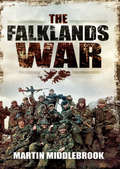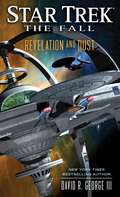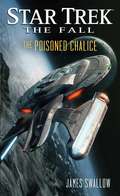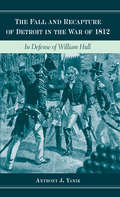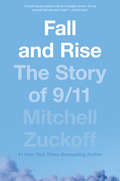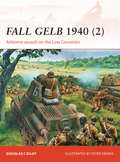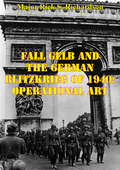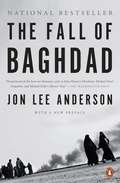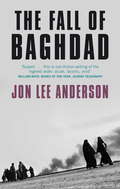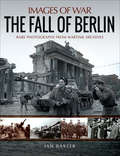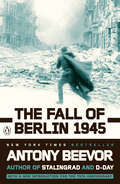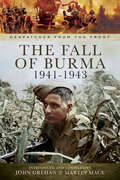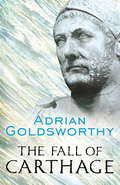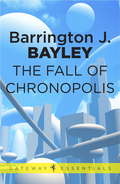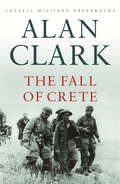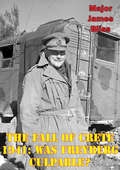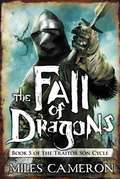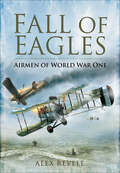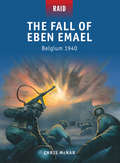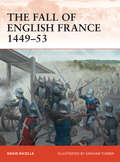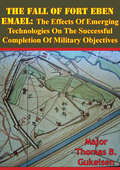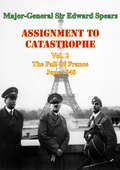- Table View
- List View
The Falklands War (Penguin Classic Military History Ser.)
by Martin MiddlebrookA detailed history of the brief 1980s conflict between the UK and Argentina, from the author of The First Day on the Somme. With the surprise Argentine invasion of the remote Falkland Islands on April 2, 1982, the United Kingdom found itself at war. Due to the resolve of a determined Prime Minister and the resourcefulness of the Armed Forces, a task force, codenamed Operation Corporate, was quickly dispatched. Remarkably, just over two months later, the islands were liberated, and the invaders defeated. By any standards this was an outstanding feat of arms, cooperation made possible by political resolve, sound planning, strong leadership and the courage and determination of the British forces. Martin Middlebrook, the renowned military historian, has skillfully weaved the many strands of this extraordinary achievement into a fascinating, thorough and highly readable account. Thanks to his meticulous research he covers action at sea, on the land and in the air as well as providing the strategic overview. The author&’s use of many first-hand accounts reveals what it was like to be part of this audacious military endeavor. The experiences of the Falkland Islanders during the Argentine occupation are also included. Thirty years on, Middlebrook&’s The Falklands War is still an authoritative and thoroughly readable account of this historic enterprise.Originally published as Operation Corporate: The Story of the Falklands War, 1982.Praise for The Falklands War&“The author&’s descriptions of confrontations in the air, on the sea and on the various battlegrounds are superb, as are his explanations of the use of new weapons, such as the Sea Harrier and the Exocet missile.&” —Publishers Weekly
The Fall: Revelation and Dust (Star Trek: The Fall)
by David R. George IIIWELCOME TO THE NEW DEEP SPACE 9.After the destruction of the original space station by a rogue faction of the Typhon Pact, Miles O&’Brien and Nog have led the Starfleet Corps of Engineers in designing and constructing a larger, more advanced starbase in the Bajoran system. Now, as familiar faces such as Benjamin Sisko, Kasidy Yates, Ezri Dax, Odo, and Quark arrive at the new station, Captain Ro Laren will host various heads of state at an impressive dedication ceremony. The dignitaries include not only the leaders of allies—such as Klingon Chancellor Martok, Ferengi Grand Nagus Rom, the Cardassian castellan, and the Bajoran first minister—but also those of rival powers, such as the Romulan praetor and the Gorn imperator. But as Ro&’s crew prepares to open DS9 to the entire Bajor Sector and beyond, disaster looms. A faction has already set in action a shocking plan that, if successful, will shake the Alpha and Beta Quadrants to the core. And what of Kira Nerys, lost aboard a runabout when the Bajoran wormhole collapsed? In the two years that have passed during construction of the new Deep Space 9, there have been no indications that the Celestial Temple, the Prophets, or Kira have survived. But since Ben Sisko once learned that the wormhole aliens exist nonlinearly in time, what does that mean with respect to their fate, or that of the wormhole...or of Kira herself?
The Fall: The Poisoned Chalice (Star Trek: The Fall)
by James SwallowThe fourth original novel in the electrifying The Next Generation/Deep Space Nine crossover event!One simple act, and the troubles of the United Federation of Planets have grown darker overnight. The mystery behind the heinous terrorist attack that has rocked the Federation to its core grows ever deeper, and William Riker finds himself beset by rumors and half-truths as the U.S.S. Titan is ordered back to Earth on emergency orders from the admiralty. Soon, Riker finds himself drawn into a game of political intrigue, bearing witness to members of Starfleet being detained—including people he considered friends—pending an investigation at the highest levels. And while Riker tries to navigate the corridors of power, Titan&’s tactical officer, Tuvok, is given a series of clandestine orders that lead him into a gray world of secrets, lies, and deniable operations. Who can be trusted when the law falls silent and justice becomes a quest for revenge? For the crew of the U.S.S. Titan, the search for answers will become a battle for every ideal the Federation stands for... ™, ®, & © 2013 CBS Studios, Inc. STAR TREK and related marks are trademarks of CBS Studios, Inc. All Rights Reserved.
The Fall and Recapture of Detroit in the War of 1812: In Defense of William Hull
by Anthony J. YanikDetails the first major U.S. setback in the War of 1812 and analyzes the background and aftermath of Hull's surrender.
Fall and Rise: The Story of 9/11
by Mitchell ZuckoffYears in the making, this spellbinding, heartbreaking, and ultimately uplifting narrative is an unforgettable portrait of 9/11. <P><P>This is a 9/11 book like no other. Masterfully weaving together multiple strands of the events in New York, at the Pentagon, and in Shanksville, Pennsylvania, Fall and Rise is a mesmerizing, minute-by-minute account of that terrible day. <P><P>In the days and months after 9/11, Mitchell Zuckoff, then a reporter for the Boston Globe, wrote about the attacks, the victims, and their families. After further years of meticulous reporting, Zuckoff has filled Fall and Rise with voices of the lost and the saved. <P><P>The result is an utterly gripping book, filled with intimate stories of people most affected by the events of that sunny Tuesday in September: an out-of-work actor stuck in an elevator in the North Tower of the World Trade Center; the heroes aboard Flight 93 deciding to take action; a veteran trapped in the inferno in the Pentagon; the fire chief among the first on the scene in sleepy Shanksville; a team of firefighters racing to save an injured woman and themselves; and the men, women, and children flying across country to see loved ones or for work who suddenly faced terrorists bent on murder. <P><P>Fall and Rise will open new avenues of understanding for everyone who thinks they know the story of 9/11, bringing to life—and in some cases, bringing back to life—the extraordinary ordinary people who experienced the worst day in modern American history. <P><P>Destined to be a classic, Fall and Rise will move, shock, inspire, and fill hearts with love and admiration for the human spirit as it triumphs in the face of horrifying events. <P><b>A New York Times Bestseller</b>
Fall From Grace
by Larry CollinsCatherine Pradier. Beautiful, sophisticated, dedicated. The most valuable agent the Allies had in France as the D-Day invasion that would decide the future of the world drew near. Hans-Dieter Stromelburg. Elegant, cultured, brilliant. And the superb architect of a diabolically perfect Nazi plan to turn the Allies' supreme undercover weapon against itself. Both knew the stakes in the game they played. But neither could be sure who was betraying whom....
Fall Gelb 1940
by Doug DildyThe German blitzkrieg conquest of France and the Low Countries (via the Ardennes, Arras, and Dunkirk) in May and June of 1940 has never been surpassed in the history of warfare in that no clash between such great and apparently equal forces has been decided so swiftly and conclusively. Not deigning to spend itself against the extensive fortifications of France's Maginot Lines, Hitler's Wehrmacht planned to advance its 136 (of 157) divisions through Belgium and northern France in order to destroy the Allied forces there and gain territory from which to prosecute continued combat operations against France and England. Beginning on 10 May 1940, this title follows the fortunes of Heeresgruppe A as its three Panzer Korps moved stealthily through the dark, hilly, and thickly forested Ardennes in southern Belgium before forcing a passage across the river Meuse and racing through France to the Channel in one of the most daring campaigns in history.
Fall Gelb And The German Blitzkrieg Of 1940: Operational Art
by Major Rick S. RichardsonThe objective of this study is to determine if the German "blitzkrieg" and Fall Gelb of 1940 were an expression of operational art. Despite the mythology surrounding Fall Gelb, the campaign does not constitute a major breakthrough in operational art by the Germans. Fall Gelb was not an expression of operational art. This conclusion is based upon an analysis using the approaches posed by U.S. Army and joint doctrine, Dr. James Schneider and Dr. Shimon Naveh.The purpose of this study is to examine more closely what is meant by "operational art" and to use those contemporary insights to re-examine German military operations in France in May 1940, Fall Gelb. Fall Gelb was chosen because it is a campaign that is frequently studied and often used and abused to illustrate various points relating to military operations. The study of the Fall Gelb campaign offers a glimpse of past operations through the lens of contemporary thought. That study provides the contemporary military professional an opportunity to improve his understanding of operational art through the study of a historical campaign.
The Fall of Baghdad
by Jon Lee AndersonFor every great historical event, seemingly, at least one reporter writes an eyewitness account of such power and literary weight that it becomes joined with its subject in our minds-George Orwell's Homage to Cataloniaand the Spanish Civil War; John Hersey's Hiroshimaand the dropping of the first atomic bomb; Philip Gourevitch's We Wish to Inform You That Tomorrow We Will Be Killed with Our Families: Stories of Rwandaand the Rwandan genocide. Whatever else is written about the Iraqi people and the fall of Saddam, Jon Lee Anderson's The Fall of Baghdadis worthy of mention in this company. No subject has become more hotly politicized than the toppling of Saddam Hussein's regime, and so a thick fog of propaganda, both from boosters of the war and its opponents, has obscured the reality of what the Iraqi people have endured and are enduring, under Saddam Hussein and now. For that reason alone, The Fall of Baghdadis a great and necessary book. Jon Lee Anderson has drawn on all of his reserves of stamina and personal bravery to create an astonishing portrait of humanity in extremis, a work of great wisdom, human empathy, and moral clarity. He follows a remarkable and diverse group of Iraqis over the course of this extraordinary time: from the all-pervasive fear that comes from living under Saddam's brutal, Orwellian rule to the surreal atmosphere of Baghdad before the invasion; to the invasion's commencement and the regime's death spiral down into its terrible endgame; to America's disastrously ill-conceived seizure of power and its fruits. In channeling a tragedy of epic dimensions through the stories of real people caught up in the whirlwind of history, Jon Lee Anderson has written a book of timeless significance.
The Fall Of Baghdad
by Jon Lee AndersonFor every great historical event, at least one reporter writes an eye-opening account of such power and literary weight that it becomes joined with its subject in our minds - George Orwell's Homage to Catalonia and the Spanish Civil War; John Hersey's Hiroshima and the dropping of the first atomic bomb; Philip Gourevitch's We Wish to Inform You That Tomorrow We Will Be Killed with Our Families and the Rwandan genocide. Whatever else is written about the Iraqi people and the fall of Saddam, Jon Lee Anderson's The Fall of Baghdad will remain the classic book about the Iraq War. No subject has become more hotly politicized than the toppling of Saddam Hussein's regime, and so a thick fog of propaganda has obscured the reality of what the Iraqi people have endured and are enduring, under Saddam Hussein and now. Jon Lee Anderson has created an astonishing portrait of humanity in extremis, a work of great wisdom, human empathy, and moral clarity. In channelling a tragedy of epic dimensions through the stories of real people caught up in the whirlwind of history, Jon Lee Anderson has written a book of timeless significance.
The Fall of Berlin (Images of War)
by Ian BaxterA photographic history of Nazi Germany&’s last days: &“The images are well chosen—this reviewer cannot recall having seen any before.&” —The NYMAS Review By March 1945, the Red Army had closed in on Berlin. Marshal Zhukov, with almost a million soldiers and 20,000 tanks and guns at his disposal, launched his assault of the Seelow Heights. While costly, with 30,000 Russians killed, it brought the Russian Army to the gates of the capital. On April 20, Hitler&’s fifty-sixth birthday, Soviet artillery began a massive bombardment of the doomed city. The Fuhrer ordered every soldier, Hitlerjugend, and Volksstrum to fight to the death. The house-to-house fighting that followed was brutal and savage, with heavy casualties for both military and civilians. Using superb Russian and German imagery, this pictorial history describes the Russian assault and Nazi last-ditch defense of Hitler&’s capital during the final days of the Third Reich.
The Fall of Berlin (Images of War)
by Ian BaxterA photographic history of Nazi Germany&’s last days: &“The images are well chosen—this reviewer cannot recall having seen any before.&” —The NYMAS Review By March 1945, the Red Army had closed in on Berlin. Marshal Zhukov, with almost a million soldiers and 20,000 tanks and guns at his disposal, launched his assault of the Seelow Heights. While costly, with 30,000 Russians killed, it brought the Russian Army to the gates of the capital. On April 20, Hitler&’s fifty-sixth birthday, Soviet artillery began a massive bombardment of the doomed city. The Fuhrer ordered every soldier, Hitlerjugend, and Volksstrum to fight to the death. The house-to-house fighting that followed was brutal and savage, with heavy casualties for both military and civilians. Using superb Russian and German imagery, this pictorial history describes the Russian assault and Nazi last-ditch defense of Hitler&’s capital during the final days of the Third Reich.
The Fall of Berlin 1945
by Antony BeevorAcclaimed for his vivid re-creations of some of the twentieth century's most significant battles, Antony Beevor is one of the best known and respected military historians writing today. He now offers readers a gripping, street-level portrait of the harrowing days of January 1945 in Berlin when the vengeful Red Army and beleaguered Nazi forces clashed for a final time. The result was the most gruesome display of brutality in the war, with tanks crushing refugee columns, mass rapes, pillage, and destruction. Hundreds of thousands of German civilians froze to death or were massacred because Nazi officials had forbidden their evacuation. Hitler, half crazed in his bunker, issued wild orders while Stalin was prepared to risk any number of his men to seize the city before the other Allies could get there. Making full use of newly disclosed material from former Soviet files as well as from German, American, British, French, and Swedish archives, Beevor has reconstructed the different experiences of those millions caught up in the death throes of the Third Reich. The Fall of Berlin 1945 depicts not only the brutality and desperation of a city under siege but also rare moments of extreme humanity and heroism. This account also contains new revelations about the motives behind Stalin's hurried assault. Sure to appeal to all readers interested in military history and the Second World War, The Fall of Berlin 1945 promises to be the definitive treatment of the subject for years to come.
The Fall of Burma, 1941–1943 (Despatches from the Front)
by John Grehan Martin MaceDespatches in this volume include that on operations in Burma between 15 December 1941 and 20 May 1942 by General Wavell; Operations in Eastern Theatre, based on India, March 1942 to 31 December 1942 by Field-Marshall Wavell; Operations in the Indo-Burma Theatre 21 June to 15 November 1942 by Field-Marshall Auchinleck; and Operations in the India Command 1 January to 20 June 1943 by Field-Marshall Wavell.This unique collection of original documents will prove to be an invaluable resource for historians, students and all those interested in what was one of the most significant periods in British military history.
The Fall of Carthage: The Punic Wars 265-146BC
by Adrian GoldsworthyThe struggle between Rome and Carthage in the Punic Wars was arguably the greatest and most desperate conflict of antiquity. The forces involved and the casualties suffered by both sides were far greater than in any wars fought before the modern era, while the eventual outcome had far-reaching consequences for the history of the Western World, namely the ascendancy of Rome. An epic of war and battle, this is also the story of famous generals and leaders: Hannibal, Fabius Maximus, Scipio Africanus, and his grandson Scipio Aemilianus, who would finally bring down the walls of Carthage.
The Fall of Chronopolis (Gateway Essentials #15)
by Barrington J. BayleyThe mighty ships of the Third Time Fleet relentlessly patrolled the Chronotic Empire's thousand-year frontier, blotting out an error of history here or there before swooping back to challenge other time-travelling civilisations far into the future.Captain Mond Aton had been proud to serve in such a fleet. But now, falsely convicted of cowardice and dereliction of duty, he had been given the cruellest of sentences: to be sent unprotected into time as a lone messenger between the cruising timeships. After such an inconceivable experience in the endless voids there was only one option left to him.To be allowed to die.
The Fall Of Crete
by Alan ClarkThe epic story of one of the most bitter and dramatic battles fought between German and Allied forces during the whole of the Second World War. The decisive action took place within five days, and twice its outcome hung in the balance. By the third day, the number of German dead exceeded their losses in all other theatres since the outbreak of hostilities. The German parachutists were confined for supply and reinforcements to a single airstrip at Maleme, yet on this one foothold they managed to land over eight thousand men, who defeated an Allied army nearly five times as numerous. With its vivid and compelling description of the battle for Crete, Clark confirmed his reputation as a military historian first recognised with The Donkeys, his account of the British Expeditionary Force in France in 1914.
The Fall Of Crete
by Alan ClarkThe epic story of one of the most bitter and dramatic battles fought between German and Allied forces during the whole of the Second World War. The decisive action took place within five days, and twice its outcome hung in the balance. By the third day, the number of German dead exceeded their losses in all other theatres since the outbreak of hostilities. The German parachutists were confined for supply and reinforcements to a single airstrip at Maleme, yet on this one foothold they managed to land over eight thousand men, who defeated an Allied army nearly five times as numerous. With its vivid and compelling description of the battle for Crete, Clark confirmed his reputation as a military historian first recognised with The Donkeys, his account of the British Expeditionary Force in France in 1914.
The Fall of Crete 1941: Was Freyberg Culpable?
by Major James BlissOn 20 May 1941, Generaloberst Kurt Student's Luftwaffe XI Fliegerkorps conducted the first operational airborne invasion in history to seize Crete. Major-General Bernard Cyril Freyberg VC, 2nd New Zealand Expeditionary Force, commanded the British forces defending the island. Freyberg, forewarned of the details of the invasion, possessed numerical superiority over the enemy, but was defeated within twelve days. Freyberg, later blamed for the defeat due to his perceived faulty defensive dispositions, was dealt a losing hand from the start. His troops consisted of those that could be rescued from the failed Greek Campaign and lacked sufficient weapons, communications, and transport to conduct the defense. Despite the best efforts of the Royal Navy, overwhelming Luftwaffe air superiority in the absence of the Royal Air Force isolated Crete and the relentless drive of the attacking German forces captured it. Poor tactical leadership by Freyberg's subordinate commanders and their failure to prosecute his operational plan led to defeat by the barest margin. While a tactical loss, Freyberg's destruction of the 7th Flieger Division resulted in Hitler never considering an operational airborne assault again. Freyberg, although accepting responsibility for the defeat, should not be held entirely culpable for the loss of Crete.
The Fall of Dragons (The Traitor Son Cycle #5)
by Miles CameronMiles Cameron is the master of intrigue and action-packed battles in this epic tale of magic and mercenaries, war, depravity, and politics, the final book of the Traitor Son Cycle.In the climax of the Traitor Son Cycle, the allied armies of the Wild and the Kingdoms of men and women must face Ash for control of the gates to the hermetical universe, and for control of their own destinies. But exhaustion, treachery and time may all prove deadlier enemies.In Alba, Queen Desiderata struggles to rebuild her kingdom wrecked by a year of civil war, even as the Autumn battles are fought in the west. In the Terra Antica, The Red Knight attempts to force his unwilling allies to finish the Necromancer instead of each other. But as the last battle nears, The Red Knight makes a horrifying discovery. . .all of this fighting may have happened before.
Fall of Eagles: Airmen of World War One
by Alex RevellThe Great War of 1914–1918 saw the rapid development of the airplane as a weapon of war. Initially its role was seen as that of reconnaissance, an extension of the cavalry, but as the war stagnated into static trench warfare, with each side facing each other across No Mans Land, the use of artillery, both in shelling enemy positions and counter-shelling his artillery, also became of prime importance. With the early development of radio communication between ground and air, airplanes also undertook the task of spotting for the artillery, and it soon became apparent that these airplanes both the reconnaissance machines and those working for the artillery could not be allowed to work unmolested, and fast fighter airplanes—both single and two seat began to make their appearance over the Western Front. Technical development was rapid. The mostly unarmed reconnaissance airplanes, and the early fighters of 1915 and 1916, armed with a single machine gun, had given way to fighters carrying two guns, flying at altitudes of over 16,000 feet and at treble the speed of the predecessors of 1914. With these developments a new type of soldier had evolved: the fighter pilot. Capable of fighting in the air, in three dimensions and at great speed, individual pilots began to emerge whose singular talents and temperament brought them to the forefront of their respective air forces. They became the aces, pilots who had brought down five or more of the enemy. Despite their expertise, few of these aces survived the war. The last combats of some are known and well documented, others are obscure. Some of the pilots in these pages are well-known, others less so, but all shared the common experience of fighting in the air during the war of 1914–1918: the conflict which saw the airplane evolve from a relatively fragile, unarmed reconnaissance machine, to a deadly weapon that changed the face of war for ever.
The Fall of Eben Emael - Belgium 1940
by Chris Mcnab Peter DennisIn early May 1940, the fortress of Eben Emael was a potent sentinel over the Belgian-Dutch borderlands. The fortress covered 75 hectares on the surface, had 5km of tunnels underground and was studded with bunkers, gun turrets and casemates. Add a garrison of 1,200 men and the natural protection of 60m-high canal walls, and Eben Emael gave the impression of near-impregnability. Yet on 10 May just 78 elite airborne soldiers managed to defeat this fortress in an operation of unprecedented tactical skill. Deployed by glider onto the very top of the fortifications, they utilized elite training, fast movement and specialist explosives to destroy many of the gun positions and trap much of the garrison within the fortress. Simultaneously, three other assault detachments conducted high-risk glider operations to capture critical bridges over the Albert Canal. By the end of 11 May, following the arrival of German infantry reinforcements, Eben Emael was in German hands. This Eben Emael RAID title tells the complete, fascinating story of this unique action.
The Fall of English France 1449-53
by David Nicolle Graham TurnerFor the overwhelming majority of people outside the French-speaking world the Hundred Years War consisted of a sequence of major English victories, above all Crécy, Poitiers and Agincourt. The only significant victor or 'hero' on the French side was Joan of Arc, and she ended up being burned at the stake. Yet somehow the war ended in a French victory and with England's martial energies being turned against itself in the Wars of the Roses. This book is intended to provide some balance. It will describe the campaign that brought the Hundred Years War to a close, with English possessions being confined to Calais and the Channel Islands. It will also explain how the somewhat unprepossessing and unmartial King Charles VII of France succeeded where his predecessors had failed. The campaign consisted of more than battles, of course, but it was marked by two major victories - at Formigny in 1450 and at Castillon in 1453. Formigny is of special interest because it saw French cavalry defeat English archers, in effect a reversal of Crécy, Poitiers and Agincourt, and could be interpreted as one of the last 'medieval' battles. Castillon is of interest because it was a victory of gunpowder artillery in fixed positions over a traditional medieval assault by mixed infantry and cavalry, and thus could be interpreted as one of the first 'modern' battles.
The Fall Of Fort Eben Emael: The Effects Of Emerging Technologies On The Successful Completion Of Military Objectives
by Major Thomas B. GukeisenThis study details the events of 10 May 1940 at Fort Eben Emael, Belgium, and the elements which led to the successful seizure of the fort by the German military. The central focus of this thesis is the following question: Was the use of emerging technologies the key to victory at Fort Eben Emael? First, the study focuses on the technologies themselves. Secondly, this study examines the leadership and training of the German unit assigned the mission at Fort Eben Emael. Lastly, this study examines administration and personnel issues that existed for the Belgians stationed at Fort Eben Emael. This study determined that the glider did afford troops the advantage of surprise; however, the hollow charge failed to live up to its reputation as it was most effective when used in such a way that it was no different than a conventional charge. Further, the German unit's training and leadership was exemplary and contributed more to the mission's success than the technologies the unit employed. Additionally, Fort Eben Emael was faced with serious internal issues that prevented a successful defence of the fort. Therefore, this thesis concludes that emerging technologies were not the most crucial component contributing to mission success.
The Fall Of France: June 1940 (Assignment To Catastrophe #2)
by Major-General Sir Edward Louis SpearsThe German victory in France at the onset of the Second World War was sudden, brutal and brilliant; by contrast the British and French preparations were miserable, faulty, badly carried through and fraught with mistrust. In the midst of these Allied responses was the eminent liaison officer Major-General Sir Edward Louis Spears, sent by the new prime Minister Winston Churchill to be his representative to the French Prime Minister. Spears was very well suited to his role as he had seen much military service and he had served in a senior liaison capacity between the British and French armies during the First World War. Keenly observant, well connected, urbane and respected by many of the French politicians and generals, his two volume memoirs are justly famous.
